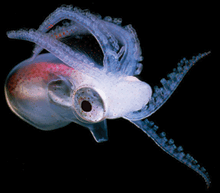 It really is gratifying to have things work the way they're supposed to. Some kind of bug bit me on Saturday and I came in to see if the periplasmic DNA preparation reported by Kahn et al 1983 would work in my hands. And sure enough it did!
It really is gratifying to have things work the way they're supposed to. Some kind of bug bit me on Saturday and I came in to see if the periplasmic DNA preparation reported by Kahn et al 1983 would work in my hands. And sure enough it did!The experiment was much the same as before. I added radiolabeled USS-1 fragments to either wild-type or rec-2 competent cell preps, incubated for 5 minutes, and then either prepared total DNA or did the periplasmic extraction (TE/1.5M CsCl + phenol/acetone, 1:1).
Since wild-type cells will take up the fragment, but also incorporate labeled subunits from degradation of taken up DNA, I can tell if the periplasmic DNA prep managed to exclude chromosomal DNA. But first, I counted the radiolabel present in the different cellular fractions...
This time, about a quarter of the USS-1 fragment added was taken up within five minutes (wild-type: 26%; rec-2: 28%). I suspect these numbers are lower than the last time I did it, because my five minutes was really five minutes (whereas the first time, I think I was 2-3 minutes late).
The extraction: When I collected the aqueous phase, I also collected the organic phase, and the interface between the phases (which should contain the cells minus their outer membranes). I counted the radiolabel in these different fractions as before:
 Wild-type cells had label in both the aqueous extract, as well as in the interface containing the cells, while rec-2 had nearly all the label in the aqueous extract. The organic phase had less than 1% rec-2.
Wild-type cells had label in both the aqueous extract, as well as in the interface containing the cells, while rec-2 had nearly all the label in the aqueous extract. The organic phase had less than 1% rec-2.But here's the important bit:
 Lane 1: Input (1/3, or 4 ng)
Lane 1: Input (1/3, or 4 ng)Lane 2: Total DNA, wild-type + USS-1 for 5 min.
Lane 3: Total DNA, rec-2 +USS-1 for 5 min.
Lane 4: Peri DNA, wild-type + USS-1 for 5 min.
Lane 5: Peri DNA, rec-2 +USS-1 for 5 min.
The important point here is that in the total DNA extract of wild-type, both intact donor USS-1 and chromosomal labeling are evident, while in the peri-extract of wild-type, there is no chromosomal label.
This means that the extraction I did successfully purified periplasmic DNA over chromosomal DNA. Fabulous!
Now I need to scale this protocol up, and get cleaner DNA (i.e. use RNase), so hopfully I can see this without using radiolabel. If I can really get clean periplasmic DNA with little or no chromosomal contamination, I will move onto doing the "real" experiment with donor DNA made up from sheared genomic DNA of another isolate.
Yay!

No comments:
Post a Comment